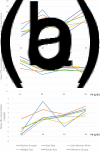Prevalence of postpartum anaemia and iron deficiency by serum ferritin, soluble transferrin receptor and total body iron, and associations with ethnicity and clinical factors: a Norwegian population-based cohort study
- PMID: 35754987
- PMCID: PMC9201879
- DOI: 10.1017/jns.2022.45
Prevalence of postpartum anaemia and iron deficiency by serum ferritin, soluble transferrin receptor and total body iron, and associations with ethnicity and clinical factors: a Norwegian population-based cohort study
Abstract
Worldwide, there are limited data on the prevalence of postpartum anaemia and iron status. The aims of the present study were to assess the prevalence of anaemia and iron deficiency (ID) by three iron indicators 14 weeks postpartum, their relations to haemoglobin (Hb) and associations with ethnicity and clinical factors in a multi-ethnic population. We conducted a population-based cohort study of 573 women followed from early pregnancy. The prevalence of postpartum anaemia (Hb <12·0 g/dl) was 25 %. ID prevalence varied from 39 % by serum ferritin (SF <15 μg/l), to 19 % by soluble transferrin receptor (sTfR >4·4 mg/l) and 22 % by total body iron (TBI < 0 mg/kg). The mean Hb concentration was 12·8 g/dl in women with no ID, 12·6 g/dl in those with ID by SF only and 11·6 g/dl in those with ID by SF, sTfR and TBI. ID by sTfR and TBI defined by the current threshold values probably identified a more severe iron-deficient population compared with ID assessed by SF. Compared with Western Europeans, the prevalence of anaemia was at least the double in ethnic minorities (26-40 % v. 14 %; P < 0·01-0·05), and the prevalence of ID by sTfR and TBI, but not of ID by SF < 15 μg/l, was significantly higher in some minority groups. After adjustment for covariates, only South Asians had lower Hb and higher sTfR concentration. Insufficient iron intake, gestational anaemia or ID, and postpartum haemorrhage were associated with lower postpartum Hb concentration and poorer iron status.
Keywords: Anaemia; Cohort; Ethnic minorities; Iron deficiency; Postpartum iron status.
© The Author(s) 2022.
Figures


Similar articles
-
The impact of recommending iron supplements to women with depleted iron stores in early pregnancy on use of supplements, and factors associated with changes in iron status from early pregnancy to postpartum in a multi-ethnic population-based cohort.BMC Pregnancy Childbirth. 2023 May 13;23(1):350. doi: 10.1186/s12884-023-05668-5. BMC Pregnancy Childbirth. 2023. PMID: 37179290 Free PMC article.
-
Serum ferritin, soluble transferrin receptor, and total body iron for the detection of iron deficiency in early pregnancy: a multiethnic population-based study with low use of iron supplements.Am J Clin Nutr. 2019 Mar 1;109(3):566-575. doi: 10.1093/ajcn/nqy366. Am J Clin Nutr. 2019. PMID: 30831600
-
Iron deficiency in early pregnancy using serum ferritin and soluble transferrin receptor concentrations are associated with pregnancy and birth outcomes.Eur J Clin Nutr. 2016 Mar;70(3):358-63. doi: 10.1038/ejcn.2015.157. Epub 2015 Sep 16. Eur J Clin Nutr. 2016. PMID: 26373962
-
Assessment of iron status in settings of inflammation: challenges and potential approaches.Am J Clin Nutr. 2017 Dec;106(Suppl 6):1626S-1633S. doi: 10.3945/ajcn.117.155937. Epub 2017 Oct 25. Am J Clin Nutr. 2017. PMID: 29070567 Free PMC article. Review.
-
Adjusting total body iron for inflammation: Biomarkers Reflecting Inflammation and Nutritional Determinants of Anemia (BRINDA) project.Am J Clin Nutr. 2017 Jul;106(Suppl 1):383S-389S. doi: 10.3945/ajcn.116.142307. Epub 2017 Jun 14. Am J Clin Nutr. 2017. PMID: 28615255 Free PMC article. Review.
Cited by
-
The impact of recommending iron supplements to women with depleted iron stores in early pregnancy on use of supplements, and factors associated with changes in iron status from early pregnancy to postpartum in a multi-ethnic population-based cohort.BMC Pregnancy Childbirth. 2023 May 13;23(1):350. doi: 10.1186/s12884-023-05668-5. BMC Pregnancy Childbirth. 2023. PMID: 37179290 Free PMC article.
-
Iron-related Biomarkers in the Diagnosis and Management of Iron Disorders.Curr Med Chem. 2024;31(27):4233-4248. doi: 10.2174/0109298673263003231228060800. Curr Med Chem. 2024. PMID: 38415440 Review.
-
Prevalence of Postpartum Anemia and Associated Risk Factors in Najran Hospitals, Saudi Arabia; A Retrospective Observational Study.Int J Womens Health. 2025 Mar 8;17:681-693. doi: 10.2147/IJWH.S503671. eCollection 2025. Int J Womens Health. 2025. PMID: 40078507 Free PMC article.
References
-
- Milman N (2011) Postpartum anemia I: definition, prevalence, causes, and consequences. Ann Hematol 90, 1247–1253. - PubMed
-
- Benoist B, McLean E, Egll I, et al. (2008) Worldwide Prevalence of Anaemia 1993-2005: WHO Global Database on Anaemia. Geneva: World Health Organization.
-
- WHO (2021) Global Anaemia estimates, 2021 Edition.
-
- Naess-Andresen ML, Eggemoen AR, Berg JP, et al. (2019) Serum ferritin, soluble transferrin receptor, and total body iron for the detection of iron deficiency in early pregnancy: a multiethnic population-based study with low use of iron supplements. Am J Clin Nutr 109, 566–575. - PubMed
Publication types
MeSH terms
Substances
LinkOut - more resources
Full Text Sources
Medical

